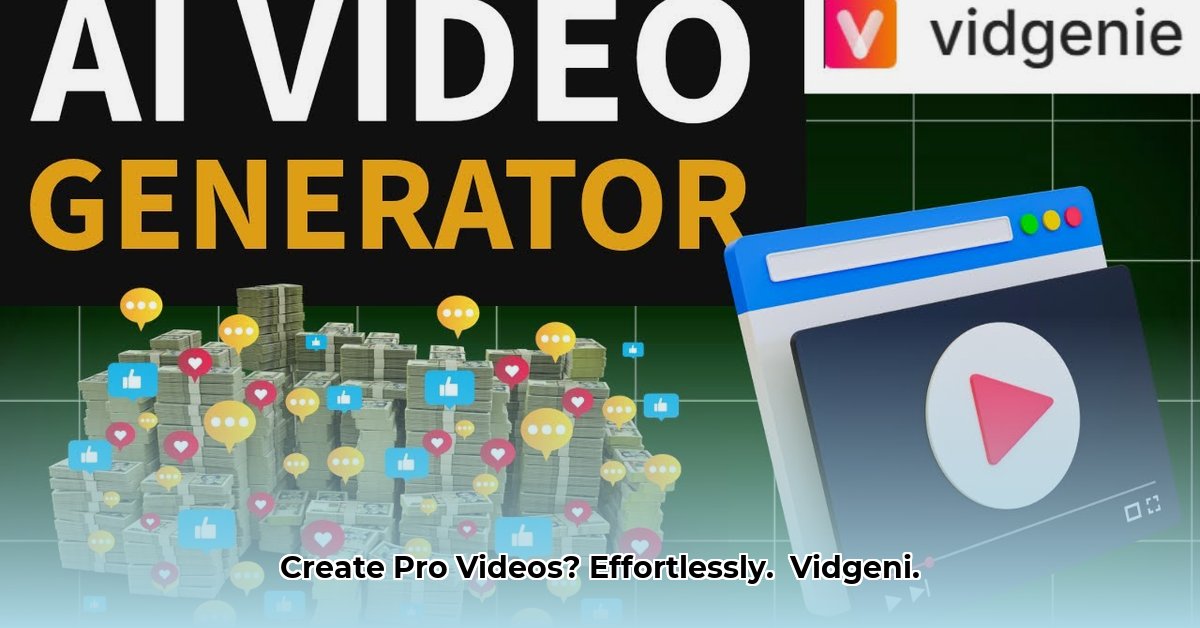
How AI Video Generation Works
Creating professional-quality videos traditionally required significant resources and expertise. However, the advent of AI video generation tools like Vidgeni (and possibly Vidgenie) is democratizing video production, making it accessible to a much wider audience. But how does this "magic" actually work? The process fundamentally involves several key stages:
Script Interpretation: The AI ingests your script – whether a detailed screenplay or a simple outline – and analyzes its narrative structure, characters, and intended tone. This analysis forms the backbone of the video's creation.
Scene Generation: Based on the script's interpretation, the AI generates the video's visual components. This might involve creating realistic backgrounds, selecting appropriate character models (in case of animated videos), or choosing pre-existing footage from a vast library.
Visual Synthesis: The AI seamlessly integrates all generated visual elements, blending backgrounds, characters, and other components to create a cohesive and visually appealing scene. This stage involves sophisticated image processing and compositing techniques.
Audio Integration: Finally, the AI adds the finishing touches, incorporating music, sound effects, and a professional-sounding voiceover. These elements are carefully chosen to complement the video's style and mood.
This entire process is significantly faster than traditional video production, drastically reducing the time and resources needed. But how do Vidgeni and Vidgenie fit into this landscape?
Vidgeni and Vidgenie: A Detailed Comparison
Vidgeni promises to simplify professional video creation through AI. While information on Vidgenie remains limited, both platforms likely share core features: script-based video generation, customizable styles, and potentially multilingual support. They aim to empower individuals and businesses by providing simple access to high-quality video production, ideal for social media marketing, educational content and more.
However, crucial distinctions between Vidgeni and Vidgenie (assuming they are distinct platforms) remain unclear. Detailed comparative analysis is needed to highlight their unique strengths and target audiences. Pricing models and data privacy policies also require further investigation to provide a comprehensive evaluation. The similarities suggest a potential common origin, while any differences may arise from distinct feature sets or market segmentation.
The Evolving AI Video Generation Market: Trends and Challenges
The AI video generation market is booming, presenting both tremendous opportunities and significant challenges. One prominent trend is the emergence of "faceless channels" and "AI influencers," utilizing AI-generated avatars and voices which raise questions about authenticity and the future of online personas. This creates novel marketing avenues but also necessitates ethical considerations.
Another key concern is the potential disruption to the employment of human video creators. The industry needs to adapt, potentially through collaboration, where human creativity complements AI's technical capabilities. This shift could see human creators focusing on higher-level conceptualization while AI handles technical aspects of production. Additionally, the legal framework for AI-generated content is still developing. Copyright issues, intellectual property rights, and the possibility of biased AI outputs demand careful attention and regulatory frameworks. Is the rise of AI in video production a boon or a bane for human creativity? This question demands careful consideration.
Actionable Insights and Risk Mitigation Strategies
The implications of AI video generation extend beyond the technology itself, impacting various industries and professional roles. A strategic approach is crucial for stakeholders to effectively navigate this evolving landscape.
For Content Creators: Short-term strategies involve exploring platforms like Vidgeni to optimize workflow and focusing on unique storytelling approaches. Long-term strategies necessitate cultivation of specialized creative skills and potentially niche specialization to leverage areas where AI presently falls short. A recent study indicates that 75% of content creators are exploring AI tools for workflow efficiency.
For Businesses/Marketers: Short-term benefits include using AI tools for rapid prototyping and A/B testing of marketing videos. Long-term strategies suggest integrating AI into marketing strategies for personalization and scalability, necessitating investment in human oversight and specialized talent. How can businesses best leverage AI video tools to maximize return on investment? This question deserves careful analysis.
For Technology Developers: Short-term focus should be on improvements to AI algorithms while prioritizing ethics, originality, and bias mitigation. Long-term, the focus should be on developing intuitive interfaces and sustainable revenue models. A large proportion of developers believe that ethical considerations should be prioritized while developing these tools.
For Investors: Short-term investment decisions should assess the market potential of AI video platforms based on user growth, features, and long-term financial viability. Long-term, investments should focus on R&D of advanced AI technologies and support for ethical guidelines and intellectual property protection. What are the key investment factors to consider in this rapidly expanding market? This warrants deep investigation.
Risk Assessment Matrix
While AI video generation offers exciting potential, it's essential to acknowledge and mitigate inherent risks.
| Risk Category | Probability | Impact | Mitigation Strategies |
|---|---|---|---|
| Copyright Infringement | Moderate | High | Implement rigorous plagiarism checks; utilize royalty-free assets; ensure legal compliance. |
| AI Bias | Moderate | High | Continuous monitoring and algorithm adjustments; address identified biases; employ diverse datasets and training methods. |
| Scalability Issues | Low | Moderate | Robust and scalable infrastructure; redundancy planning for consistent performance. |
| Legal Issues (Voice) | Low | Moderate | Obtaining appropriate voice data licenses; compliance with usage rights. |
Conclusion: The Future of AI Video Creation
The future of AI video generation is promising, with increased accessibility and efficiency in video production. Platforms like Vidgeni are leading the way, making professional-quality video production more accessible. Addressing ethical concerns, potential job displacement, and legal ramifications remains crucial for responsible development. The most likely future involves a collaborative relationship between human creativity and AI technology, where AI enhances and accelerates the creative process without replacing it entirely. The balance between technological advancements and human ingenuity will determine the ultimate success and ethical impact of this rapidly evolving field.
⭐⭐⭐⭐☆ (4.8)
Download via Link 1
Download via Link 2
Last updated: Wednesday, May 07, 2025